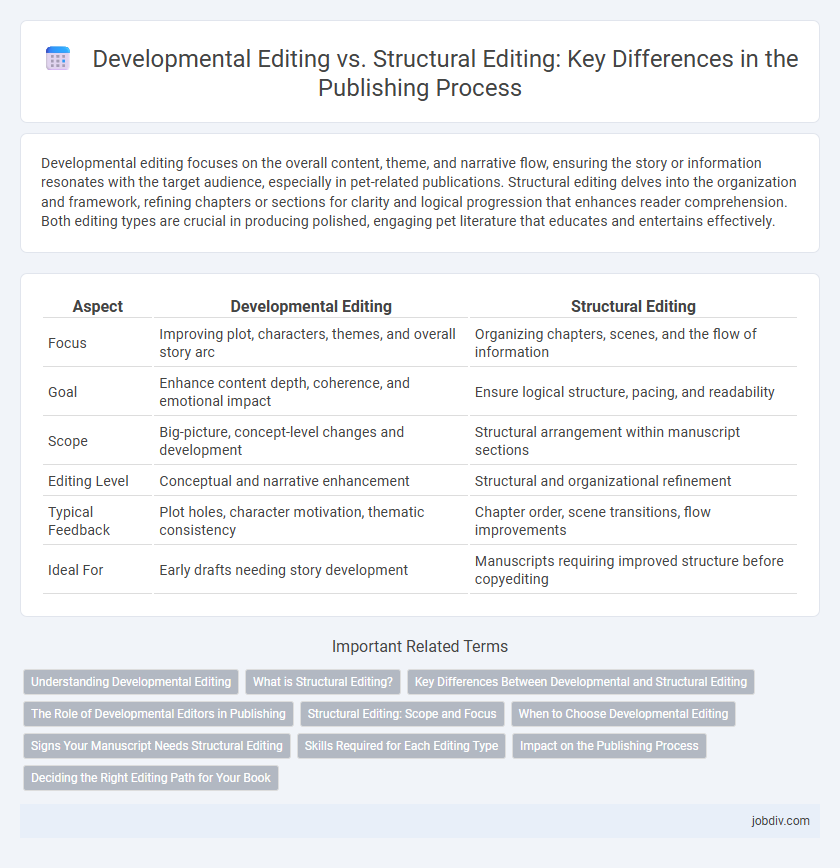Developmental editing focuses on the overall content, theme, and narrative flow, ensuring the story or information resonates with the target audience, especially in pet-related publications. Structural editing delves into the organization and framework, refining chapters or sections for clarity and logical progression that enhances reader comprehension. Both editing types are crucial in producing polished, engaging pet literature that educates and entertains effectively.
Table of Comparison
| Aspect | Developmental Editing | Structural Editing |
|---|---|---|
| Focus | Improving plot, characters, themes, and overall story arc | Organizing chapters, scenes, and the flow of information |
| Goal | Enhance content depth, coherence, and emotional impact | Ensure logical structure, pacing, and readability |
| Scope | Big-picture, concept-level changes and development | Structural arrangement within manuscript sections |
| Editing Level | Conceptual and narrative enhancement | Structural and organizational refinement |
| Typical Feedback | Plot holes, character motivation, thematic consistency | Chapter order, scene transitions, flow improvements |
| Ideal For | Early drafts needing story development | Manuscripts requiring improved structure before copyediting |
Understanding Developmental Editing
Developmental editing focuses on shaping the overall content, structure, and narrative flow to enhance a manuscript's clarity, coherence, and engagement. It involves evaluating plot development, character arcs, pacing, and thematic elements to ensure a compelling and well-organized story. This process often precedes structural editing, which fine-tunes the manuscript's framework and organization at a more detailed level.
What is Structural Editing?
Structural editing focuses on the organization, flow, and framework of a manuscript by evaluating plot coherence, chapter arrangement, and pacing to enhance overall readability. It involves rearranging sections, refining narrative structure, and ensuring that major elements support the story's purpose and target audience. This type of editing addresses big-picture issues to create a solid foundation before moving on to detailed line editing or copyediting.
Key Differences Between Developmental and Structural Editing
Developmental editing focuses on shaping the overall content, narrative, and conceptual foundation of a manuscript, addressing elements like plot, character development, and pacing. Structural editing concentrates on the organization and framework, refining chapter arrangement, scene order, and logical flow to ensure coherence and readability. Key differences include developmental editing's emphasis on big-picture storytelling and idea development, whereas structural editing fine-tunes the manuscript's internal architecture and sequencing.
The Role of Developmental Editors in Publishing
Developmental editors play a crucial role in publishing by focusing on the manuscript's overall content, structure, and flow to enhance storytelling and coherence. They collaborate closely with authors to refine plot, character development, pacing, and thematic elements, ensuring the narrative resonates with the target audience. Unlike structural editing, which addresses the organization and clarity of the manuscript, developmental editing involves a deeper analysis of the creative elements that shape the book's core message and emotional impact.
Structural Editing: Scope and Focus
Structural editing focuses on the organization and framework of a manuscript, ensuring that the plot, pacing, and narrative flow align with the intended audience and genre conventions. It involves comprehensive assessment of story arcs, chapter arrangement, and character development to enhance coherence and readability. Unlike developmental editing, which may address broader thematic elements, structural editing zeroes in on the manuscript's architecture to optimize clarity and engagement.
When to Choose Developmental Editing
Developmental editing is essential when the manuscript requires significant content reorganization, plot enhancement, or character development to strengthen the story's foundation before moving to line or copy editing. Authors often choose developmental editing during early drafting stages to clarify themes, improve pacing, and ensure coherent narrative flow. This editing form is ideal for complex projects needing holistic structural feedback rather than isolated sentence-level corrections.
Signs Your Manuscript Needs Structural Editing
Signs your manuscript needs structural editing include inconsistent pacing, unclear narrative flow, and weak plot development that hinders reader engagement. Structural editing addresses major issues like disorganized chapters, confusing story arcs, and underdeveloped characters to create a cohesive and compelling manuscript. Identifying these problems early ensures the foundation of your book supports effective developmental editing later.
Skills Required for Each Editing Type
Developmental editing requires strong storytelling insight, the ability to evaluate plot cohesion, character development, and thematic consistency, alongside excellent communication skills to guide authors through substantial manuscript revisions. Structural editing demands expertise in narrative flow, pacing, and organization, with a sharp eye for identifying gaps or redundancies in chapter structure and scene sequencing. Both editing types necessitate critical thinking and deep knowledge of genre conventions, but developmental editors often focus more on big-picture conceptual issues, while structural editors specialize in refining the manuscript's framework for clarity and impact.
Impact on the Publishing Process
Developmental editing focuses on enhancing the manuscript's core elements, such as plot, character development, and pacing, which significantly improves the story's overall coherence before moving to production stages. Structural editing refines the organization and flow of the manuscript, ensuring chapters and sections transition smoothly, thereby streamlining the layout and design phases in publishing. Both editing types reduce downstream revisions, accelerating time-to-market and improving the final book quality for publishers and readers alike.
Deciding the Right Editing Path for Your Book
Deciding between developmental editing and structural editing depends on the manuscript's needs, with developmental editing addressing big-picture elements like plot, character development, and pacing, while structural editing focuses on organization, chapter flow, and coherence. Authors seeking to enhance narrative depth and thematic consistency benefit from developmental editing, whereas structural editing is ideal for refining the manuscript's framework and ensuring logical progression. Choosing the appropriate editing path maximizes the book's potential, improves readability, and aligns the final product with publishing standards.
Developmental Editing vs Structural Editing Infographic

 jobdiv.com
jobdiv.com